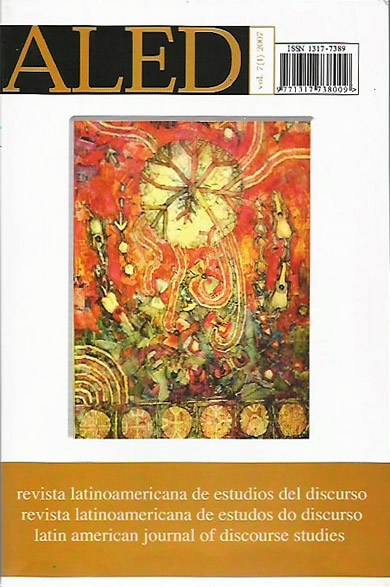Reconstruyendo los paradigmas orientales de los estudios del discurso
Mots-clés :
estudios del discurso. paradigmas orientales. Análisis Crítico del Discurso (ACD). comunidades subalternas. enfoque chino.Résumé
En este trabajo sostengo que existen razones genuinas y condiciones importantes para reconstruir los paradigmas orientales de los estudios del discurso más allá de los enfoques actuales, universalistas pero centrados en Occidente. En primer lugar, muestro las limitaciones y las consecuencias humanas del proyecto proliferante del Análisis Crítico del Discurso (ACD) occidental. En segundo lugar, y más importante, identifico varias características de los discursos de Asia, África, Latinoamérica y otras comunidades subalternas, así como sus recursos académicos relevantes. Finalmente, para ilustrar las estrategias de este trabajo de reconstrucción, considero las maneras de forjar un enfoque chino para analizar discursos tanto propios como globales.
Téléchargements
Références
ASANTE, M. K. (1998). The Afrocentric Idea. Revised and expanded ed. Philadelphia: Temple University Press.
BRADY, A-M. (2002). Regimenting the public mind: the modernisation ofpropaganda in the PRC. International Journal. 57 (4): 563-78.
CAREY, J.W. (1992). Communication as Culture: Essays on media and society. NewYork: Routledge.
CHEN G-M. (2004). The two faces of Chinese communication. HumanCommunication. 7: 25-36.
CHEN, G-M (2006). Asian communication studies: what and where to now. TheReview of Communication. 6 (4): 295-311.
CHEN G-M & W. J. STAROSTA (2003). Asian approaches to human communication:a dialogue. Intercultural Communication Studies. XII (4): 1-15.
CHESEBRO, J. (1996). Unity in diversity: multiculturalism, guilt/victimage, anda new scholarly orientation. Spectra. 32 (12): 10-14.
CHU, L.L. (1989). “In search of an Oriental communication perspective”, enChristian Academy (ed.). Continuity and Change in Communications in Post-Industrial Society, pp. 2-14. Seoul: Wooseok Publishing Co.
DISSANAYAKE, W. (ed.) (1988). Communication theory: The Asian perspective.Singapore: Asian Mass Communication Research and Information Center.
DISSANAYAKE, W. (2003). Asian approaches to human communication: retrospectand prospect. Intercultural Communication Studies. XII (4): 16-37.
FAIRCLOUGH, N. (1992). Discourse and Social Change. Cambridge: Polity Press.FANON, F. (1986). Black Skin, White Masks. Trans. C. L. Markmann. London:Pluto Press.
GERGEN, K. (1999). An Invitation to Social Construction. London: SagePublications.
GORDON, R. (1999). A spectrum of scholars: multicultural diversity and humancommunication theory. Human Communication. 2 (1): 1-8.
HEISEY, D. R. (ed.) (2000). Chinese Perspectives in Rhetoric and Communication.Stamford, CT: Ablex.
HIDALGO, M. (ed.) Mexican Indigenous Languages at the Dawn of the Twenty FirstCentury. The Hague: Mouton.
HORNBERGER, N. H. (ed.) Indigenous Literacies in the Americas: Language Planningfrom the Bottom Up. Berlin: Mouton de Gruyter.
ISHII, S. (2001). An emerging rationale for Triworld communication studies fromBuddhist perspectives. Human Communication, 4 (1): 1-10.
LAUF, E. (2005). “National diversity of major international journals in the fieldof communication”. Journal of Communication, March: 139-51.
LIN, A. N. (2001). “The great firewall”. Recuperado en 02/01/07: http://www.cpj.org/Briefings/2001/China_jan01/Great_Firewall.pdf.
LIU, Y. (1996). “To capture the essence of Chinese rhetoric: Anatomy of aparadigm in comparative rhetoric”, Rhetoric Review. 14 (1): 318-34.
KINCAID, D. L. (ed.) (1987). Communication Theory: Eastern and Westernperspectives. San Diego, CA: Academic Press.
MARTIN, J.N. & T.K. NAKAYAMA (2006). “Communication as Raced”, en G.J.Shepherd, J. St. John & T. Striphas (eds.), Communication as””: perspectiveson theory, pp. 75-83. London: Sage Publications.
MIIKE, Y. (2004). “Rethinking humanity, culture, and communication: Asiacentriccritiques and contributions”. Human Communication, 7 (1): 69-82.
MIIKE, Y. (2006). “Non-western theory in western research? An Asiacentricagenda for Asian communication studies”, The Review of Communication,6 (1/2): 4-31.
SHI-XU (2005). A Cultural Approach to Discourse. Houndmills/New York: PalgraveMacmillan.
SHI-XU (2006a). “Editorial: researching multicultural discourses”. Journal ofMulticultural Discourses. 1(1): 1-5.
SHI-XU (2006b). “A multiculturalist approach to discourse theory”. Semiótica.158 (1/4): 383-400.
SHI-XU (ed.) (2007). Discourse as Cultural Struggle. Hong Kong: Hong KongUniversity Press.
SHUTER, R. (2000). “Ethnics, culture, and communication: an interculturalperspective”, en L. A. Samovar & R. E. Porter (eds.), Intercultural Communication: A reader, pp. 443-50. Belmont, CA: Wadsworth PublishingCompany.
SPIVAK, G. C. (1988). In Other Words: Essays in cultural politics. New York:Routledge
STRATTON, J. & I. ANG (1996). “On the impossibility of a global cultural studies:‘British’ cultural studies in an ‘international’ frame”, en D. Morley & K-H.Chen (eds.), Stuart Hall, pp. 361-91.London: Routledge.
VAN DIJK, T. A. (1997). The Study of Discourse. Discourse Studies: a Multidisciplinary Introduction. Vol.1. pp. 1-34. London: Sage.
Téléchargements
Publié-e
Comment citer
Numéro
Rubrique
Licence

Cette œuvre est sous licence Creative Commons Attribution - Pas d'Utilisation Commerciale - Pas de Modification 4.0 International.
Los/as autores/as conservan los derechos de autor/a y garantizan a RALED el derecho de ser la primera publicación del trabajo al igual que licenciado bajo una Creative Commons Attribution License BY-NC-ND 4.0 que permite a otros compartir el trabajo con un reconocimiento de la autoría del trabajo, copiar y redistribuir el material en cualquier medio o formato.
Os/As autores/as conservam os direitos autorais e garantem a RALED o direito de ser a primeira publicação do trabalho licenciado por uma Creative Commons Attribution License BY-NC-ND 4.0 que permite compartilhar o trabalho com reconhecimento de sua autoria e cópia e redistribuição do material em qualquer meio ou formato.




